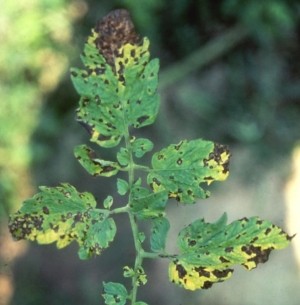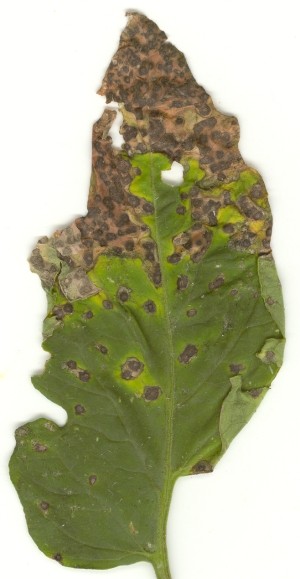Septoria Leaf Spot
 Causal Agent
Causal Agent
The fungus, Septoria lycopersici
Hosts
Tomato
Symptoms
 The disease first appears on the lower leaves after the plant has set fruit. Leaf
spots begin as yellow areas that later become circular with gray centers and dark
borders. Spots may reach 1/8 inch in diameter and be surrounded by a yellow halo.
Tiny black specks, which are fruiting structures that release spores, develop in the
center of these spots. Severely infected leaves fall off. Defoliation progresses from
the base of the plant upwards and resembles early blight from a distance. However,
the larger dark lesions with concentric rings of early blight are clearly different
from small, speckled lesions of Septoria leaf spot. Loss of foliage may cause fruits
to become sunscalded. Most infection early in the season probably arises from infested
plant debris remaining in the soil from a previous tomato crop. Spores of the fungus
are spread by splashing rain. The disease is favored by moderate temperatures and
extended periods of high relative humidity.
The disease first appears on the lower leaves after the plant has set fruit. Leaf
spots begin as yellow areas that later become circular with gray centers and dark
borders. Spots may reach 1/8 inch in diameter and be surrounded by a yellow halo.
Tiny black specks, which are fruiting structures that release spores, develop in the
center of these spots. Severely infected leaves fall off. Defoliation progresses from
the base of the plant upwards and resembles early blight from a distance. However,
the larger dark lesions with concentric rings of early blight are clearly different
from small, speckled lesions of Septoria leaf spot. Loss of foliage may cause fruits
to become sunscalded. Most infection early in the season probably arises from infested
plant debris remaining in the soil from a previous tomato crop. Spores of the fungus
are spread by splashing rain. The disease is favored by moderate temperatures and
extended periods of high relative humidity.
Control
Crop rotation and thorough shredding and incorporation of infested plant residue soon after harvest are recommended to reduce Septoria leaf spot. Weed control should be maintained because jimsonweed, horse nettle, and nightshade are also sources of infection. Drip but not sprinkler irrigation is recommended to reduce periods of leaf wetness and water splashing. Avoid working plants while foliage is wet. A fungicide spray schedule for early blight is usually effective for control of Septoria leaf spot except that the spray interval should be shortened to 7-10 days. Please contact your local county extension office for current information.
